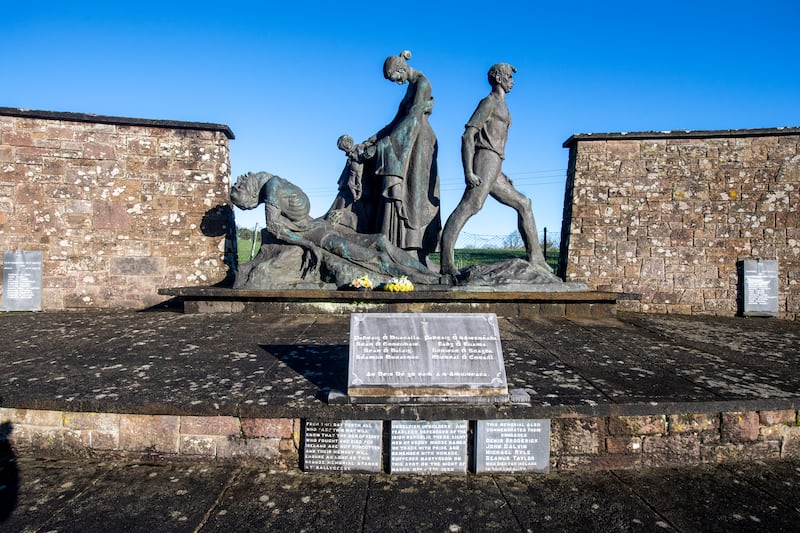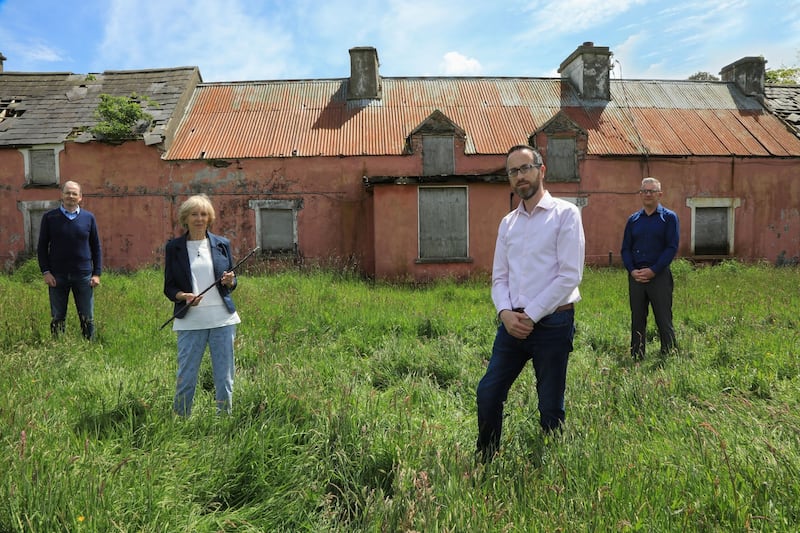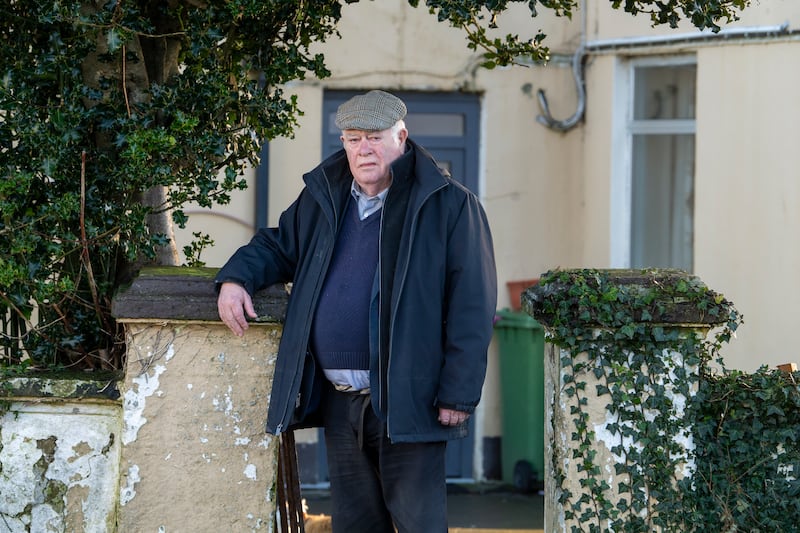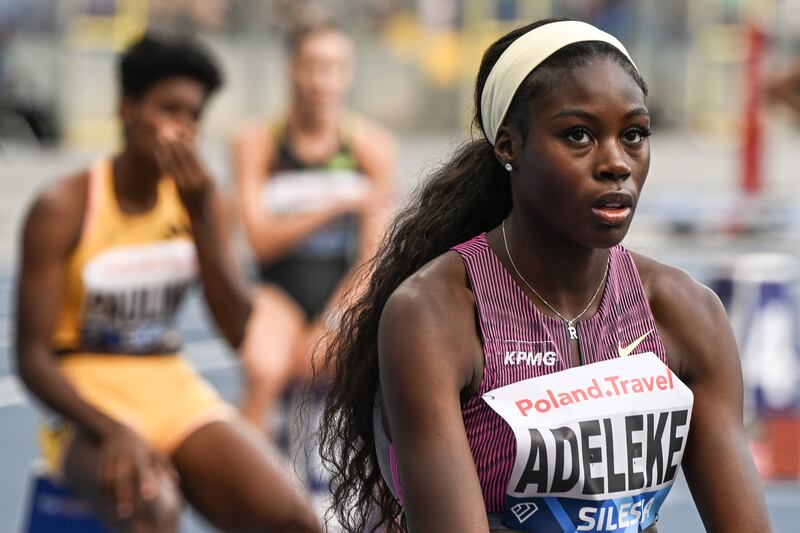“Of course, ‘twas a miracle,” Paudie Fuller says of the Civil War trap-mine explosion that was detonated almost 100 years ago at Ballyseedy Cross, outside Tralee, Co Kerry, obliterating and killing eight of the nine republican prisoners who were tied to it. Only his father, Stephen Fuller, survived.
“Of course, it was. I said that to him and he said: ‘It was just the way the mine went up.’ It went every way except his way. It was the luck of the draw. But” – and Fuller leans on to leather armrest pointing his finger to accentuate every word – “it did not affect him mentally.”
We are in the hills above the village of Kilflynn, in the handsome farmhouse that Stephen Fuller built 90 years ago for IR£50. Paudie Fuller, now 81, still lives in his childhood home and farm. From the doorway, there’s a commanding view of north Kerry. It was in the surrounding hills, snow-capped today, that his father spent on the run, as an anti-Treaty republican volunteer for the years through the War of Independence and the Civil War. The Fullers go back generations here. But the name is associated with the atrocity at Ballyseedy.
“They say it was a reprisal for Knocknagoshel. In today’s terms, they were war crimes. They were. To take eight, nine people and tie them up and put a bomb in the middle of them and blow them to pieces? Jesus, that is brutal murder.”
Excitement, boredom, but most of all, duty - the reasons southern Protestants fought in World War II
Partition was a male invention. Gender impacted on how revolutionary events unfolded, and how partition was remembered
The Irish Republican Brotherhood 1914-1924: Diarmaid Ferriter on a very personal Fenian story
A century on, the series of events that took place in north Kerry in 1923 are difficult to imagine. In the early hours of March 6th, eight Free State soldiers were sent to search for a reported IRA arms cache at Knocknagoshel. It was a trap, loaded with explosives and detonated by republican volunteers hidden about a mile away. Five soldiers were blown up and a sixth man needed a double leg amputation.

The reprisal, issued by the notoriously violent Paddy O’Daly, Brigadier in the newly created Irish National Army, was instantaneous. The following night, March 7th, nine republican prisoners were taken from Ballymullen Barracks in Tralee to Ballyseedy Cross. Officially, their task was to clear rubble. But the men were informed they were to be blown up as they left.
A lot of important men came here. De Valera was here. Seán Lemass came here. Charlie Haughey came here. All here to visit him
— Paudie Fuller
“Anyone didn’t say anything,” Stephen Fuller said in his only public interview, given in 1980 to the historian Robert Kee for his in-depth series Ireland: A Television History. Stephen Fuller was 80 years old then and spoke formally, without drama or emotion. But the strain of recollection was evident on his face.
“They tied us then, our hands behind our back and left about a foot between the next fella. And they tied us then in a circle around the mine and they tied our legs then and the knees as well with a rope and they took off our caps then and said we could be praying away as long as liked. And the next fella to me said his prayers and I said mine too. But I still kept watching where they went, like. It was that that saved me afterwards. But he said goodbye then and I said goodbye and the next fella picked it up and said, goodbye, goodbye lads and up it went. And I went up with it, of course.”
The Freeman’s Journal reported on March 9th, 1923, that the men were “mangled beyond recognition. Parts of their limbs and flesh with pieces of their clothing were found adhering to trees and strewn along the road and fields over one hundred yards from the scenes of the explosion.” The Journal listed Stephen Fuller as among the dead: when his body was not found, the assumption was that there was simply nothing left of him. His parents believed him dead for months afterwards, while he recovered from his grave injuries in a safe house and lay low.
“He didn’t talk much about it,” Paudie Fuller says now.
“Any of them never spoke. Whether it was a code of secrecy, I don’t know. I did ask him at one particular time why they were reluctant. And the answer he gave me was: ‘It hurt too much.’
Paudie Fuller went everywhere with his father. “We were more like brothers, man,” he says with conviction.
Surviving Ballyseedy conferred a curious kind of fame on Stephen Fuller. Men would come up to shake his hand at marts.
“Twould be discussed with visitors coming, relations coming, too. They would ask him questions about it. He was badly broken up with pains, too, because the bomb shattered him.”
He makes it clear his father went on to have a rich and full life. He married, twice, raised a family, farmed, and served as a TD for eight years. He was blessed with an optimistic disposition. But he represented a generation of Kerry people who carried the shadow-memories of those years and had none of the tools to make sense of them. Silence was the only medicine.
The role of the GAA was massive. My cousins and my father and uncle played Gaelic football in Listowel. You were playing on the same side as people you might have fought against
— Fergal Keane
“He was only 21 when it happened. He was able to work away – but not at full capacity. It was very easy to get on with him. But if you quizzed him, like, sometimes he would answer. More times he would not.”
Paudie Fuller’s wife Mary died three years ago. Photographs of children and grandchildren line the dresser. The place has changed little except that it’s toasty as an oven: Fuller had an ecosystem installed a few years ago. What was once the parlour, the good room – “the coldest room in Ireland” – is now a pleasant television room.
“A lot of important men came here. De Valera was here. Seán Lemass came here. Charlie Haughey came here. All here to visit him. Dev was here three or four times. Strange man. Big, tall lanky man with the long black coats. And he would stay for three or four hours below in that room. My mother would make tea for him and bring in biscuits. Tralee was his house then – the Grand Hotel. And they would go into the Grand Hotel and the rest was history then.”
The end of the Civil War in May 1923 and the swift resumption of civil – ordinary – life made the extreme violence which took a grip across the county impossible to rationalise. Remembering was simply too dark.
Fergal Keane, the BBC foreign correspondent who wrote the book Wounds: A Memoir of War and Love, says: “When the relatives came to get the coffins for Ballyseedy, the army band were playing jazzy, ragtime tunes. I could only find one source for that – from [IRA officer] Ernie O’Malley’s interviews. But dear God, it does not sound like something that someone would make up. I thought, if you want to encompass the bitterness of Civil War, it is that act. It makes you go cold reading it.”

As a child visiting Listowel, Keane knew that there was something big had happened in the life of his grandmother. After years of reporting from the most violent parts of the world, he revisited the period in his book, an evocative account of the extraordinary lives of his grandmother, Hannah Purtill, an active member of Cumann na mBann and her brother Mick.
“The thing that struck me researching Wounds, looking at my grandmother’s background and [IRA man and Kerry footballer] Con Brosnan: these were people who never inflicted violence on people. How you went from that in 1918 to the horrors that took place in the space of four years.”
Keane was born in 1961. What his generation witnessed, or sensed, were the attempts of the Civil War participants to grapple with the legacy and traumas what they had experienced. The reluctance to talk about it was understandable: the atrocities were horrendous, the divide stark and people had to get on with the practical business of making communities together.
“The role of the GAA was massive. My cousins and my father and uncle played Gaelic football in Listowel. You were playing on the same side as people you might have fought against. It was deeper than just civility. But it says a lot of how the trauma was buried when you look at the strength of the literary tradition in the area. It is not something that writers like John B [Keane] or Bryan McMahon tackled. There was almost a tacit agreement: they would refer to Civil War politics. But what did that mean apart from the fact that we had Fianna Fáil and Fine Gael and the choice between them?”
The historian Owen O’Shea was struck by the absence of reference to the Civil War in school or homes when he was growing up in the 1980s. Last year, he published No Middle Path, a fine and scrupulously fair account of the terrible turn the war took in Kerry even as it was petering out in most other counties.
“One of the most frequent remarks I get from people who read the book is, ‘We didn’t hear any of this from our parents our teachers.’ I think that points to a kind of a State-sanctioned silence about the Civil War.”

The unadorned accounts of the assassinations, executions, beatings, ambushes, and the constant mental stress on locals are harrowing. But as O’Shea lays out, so too were the lifelong struggles many activists and their families faced afterwards.
“In many ways it is the survivors – the widows, widowers, sons and daughters – who were left bereaved who really should be acknowledged for what they endured for decades afterwards. I hope there will be political engagement at Government level as well in recognising that what happened in Kerry was so different to the rest of the country, and that this was an incredibly painful time and still is for a lot of people.
“The poverty and hardship and nervous breakdowns. There might be a perception that it was only anti-Treaty families who suffered financially. But there was no monopoly on poverty or psychological breakdown. There are still people around who are sons and daughters of those who died, and they should be included.”
Meanwhile, Tim Coffey (76) speaks over the phone about how life turned out for his father, Tadhg Coffey, also a republican volunteer, after he somehow made it through a bomb and haze of bullets at a similar atrocity in the Countess Bridge trap-mine, near Killarney, on March 7th, 1923. In the immediate aftermath, he was spirited to Dublin and hid out in a house belonging to Countess Markievicz.
He worked in America for a decade, then returned to farm and raised a family. When de Valera would visit Killarney, he would invite Tadgh Coffey to meet him at the Great Southern Hotel; it was where Coffey had been imprisoned, beaten, and tortured during the war. Civility prompted him to reply when people asked him about his experience, but he never voluntarily mentioned it. Like many, he suffered in silence.
“He wasn’t too great,” says Tim Coffey. “He had a lot of problems with his back, and he suffered from depression. He would often give a week in bed. That is when it really affected him. But I know he only passed the Countess Bridge on one occasion in his life. And he had no choice. They were drawing turf on a lorry and they were struggling to get under the Railway Bridge to come into Killarney. So they had to pass the Countess Bridge.”
Tim Coffey believes it wasn’t so much a bitterness that defined the atmosphere in Kerry between Free State and republican families afterwards as a residual awareness. “People mightn’t drink in certain pubs or visit certain shops,” he says.
But an inherent dignity and reserve prevailed. It was Paudie Fuller who persuaded his own father to give the famous television interview to Robert Kee.
“But he never told me it was done for British television! Kee promised me faithfully that he would give me a copy of the full interview and he never did. They were four or five days at it. And there was a clock up on the wall and it had to be stopped for the pendulum was picking up on the recording. He [his father, Stephen] didn’t want to do it all. The reason I persuaded him was that there were no records of anything that happened. You need to put it down on record. And he agreed then. Other than that, he wouldn’t have done it.”
Paudie Fuller once asked his father if he ever saw Paddy O’Daly afterwards and if there was ever any thought of shooting him.
Paudie describes his father’s response: “‘I thought about it a lot,’ he said. ‘And I was going to do it. But I thought it better to let him live with it. It affected those fellas as well, like.’”
His father’s way of coping was to hold no bitterness. Paudie Fuller has followed that path. When he was invited in 2013 to attend a ceremony at the memorial in Knocknagoshel, which has twice been vandalised within the past decade, he decided to accept. Jimmy Deenihan, the Kerry football great and former Fine Gael minister, said that through that gesture, Paudie Fuller had “done more than any other man in North Kerry to bring us all together”.
“I still think it was the right thing to do. There were a few people not happy that I was there. All auld fellas. But the way I answered them was, you can’t keep a grudge forever. He [my father] would not have objected to it. That was his attitude as well. He was not bitter towards it.”
We drive down to the memorial at Ballyseedy. Cars spin by as Fuller stands at the spot where the atrocity took place. A small sign advertises a centenary event to be held on March 7th. Fuller’s eyes are streaming. He insists he’s fine. It might be the icy air. Back at the house, he is silent for a moment when asked if the sacrifice and courage and killings that shaped the Republic were worth it.

“Probably not. Nah. It put brother against brother and it hurt too much. And there were too many killed. There is still hatred around over it. At the 70th anniversary, I got all the families of the people blown up and got a Mass together. And we had a commemoration at the monument. We went back for a cup of tea in the hotel. There was no problem in getting those families together. But those families didn’t even get an apology.”
Perhaps it is not too late. In March, across Kerry, sombre centenary ceremonies of reflection will take place. The ageing children of the Civil War generation will take gather to pay tribute to an extraordinary generation of stoical people. A century on, a respectful conversation about what it all meant has begun.
“It should be remembered,” Tim Coffey says, speaking slowly down the phone line.
“It is the last opportunity to speak about these things. And to recognise them.”



















